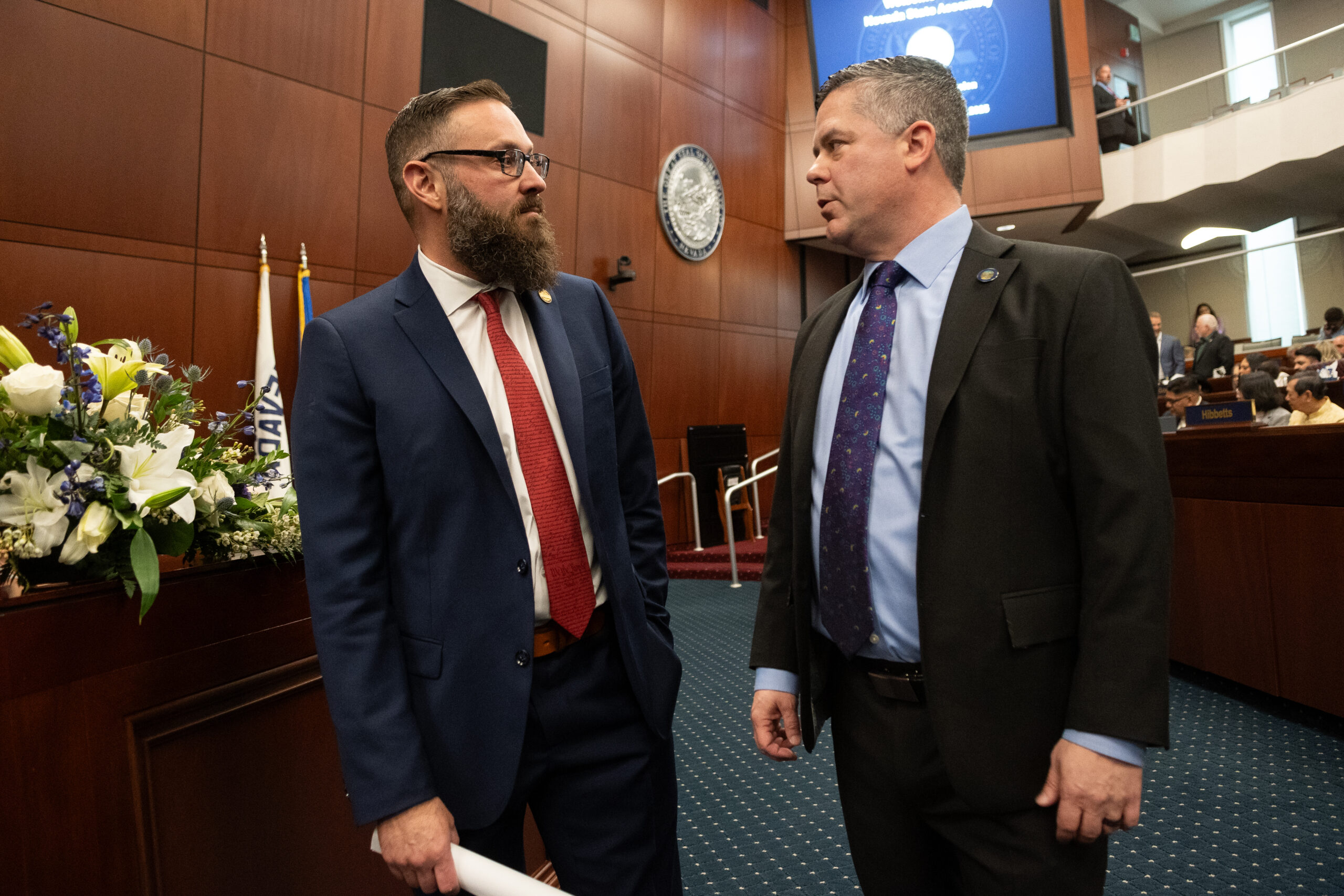Voting records from 2025 Nevada legislative session show continued polarization

Moderates have historically been an endangered species in the Nevada Legislature — and that didn’t change in 2025.
Although some of Nevada’s 63 lawmakers have a higher penchant for voting across the aisle, a Nevada Independent analysis of votes on hundreds of bills from the 2025 session showed that moderate voting records were the exception, rather than the norm.
Using a prominent software designed to measure political partisanship in Congress and state legislatures, The Indy charted where all Nevada legislators fell on the political spectrum during the 2025 session.
The results? Only two lawmakers found themselves closer to the middle of the spectrum than the farthest extremes: freshmen Sens. Lori Rogich (R-Las Vegas) and John Steinbeck (R-Las Vegas). This was the lowest number since at least 2011.
The analysis stemmed from a collection of all legislative roll call votes since 2011, which is the earliest data available from LegiScan, a website that tabulates votes from Congress and state legislatures. The software was then used to analyze the votes, creating a chart that maps where lawmakers fall on the ideological spectrum. A lawmaker’s place on the chart is based on which other legislators they were most likely to vote alongside.
The software rates a lawmaker’s political lean on a scale of -1 to 1. Lower numbers indicate times when legislators were more likely to vote alongside Democrats, while higher numbers indicate a Republican lean. Moderates tend to hover around the middle.
The software does not take into account bills that passed unanimously, which accounted for more than half of all legislation that advanced out of both chambers this year. It means that cross-party collaboration still happens frequently, but when votes are not unanimous (those reflected in The Indy’s analysis), adherence to the party line becomes much starker. Legislators also tout their work across party lines behind the scenes to amend bills, which is not reflected in this data.
However, there is mounting evidence that the Legislature is becoming more partisan. The number of bills that passed unanimously dropped this session (though it was higher than in 2021), as did the number of times a legislator bucked their own party. There were also much fewer legislators near the middle of the ideological spectrum than in past years, particularly on the Republican side.
The findings underscore that Nevada is no exception to the increasing partisanship that has engulfed statehouses as national politics becomes more divisive.
“This is consistent with national trends and the increasing nationalization of state legislatures,” said David Damore, a UNLV political science professor.
Where lawmakers fell
Rogich and Steinbeck, both freshman lawmakers representing some of the most purple districts in the state, had the most moderate voting records.
The rating isn’t a surprise — by the end of the session, they had each voted in favor of about 50 bills that most Republicans opposed, nearly double any other lawmaker.
They were also the only Republicans to vote for about a dozen bills, including the proposal to require insurance coverage of in vitro fertilization (SB217) that was vetoed by Gov. Joe Lombardo.
In an interview last month, Steinbeck described himself as a “middle conservative.”
“I'm not overly concerned with whether [a bill] is right, left or middle,” Steinbeck said.
Rogich, who did not respond to an interview request, previously told The Indy that “I believe in voting based on what is best for our community, even if it means stepping beyond traditional party boundaries."
The third-most moderate voting record belonged to Assm. Gregory Koenig (R-Fallon), who represents one of the reddest Assembly districts in the state and was the most moderate legislator during the 2023 legislative session.
Koenig also rounded out the top three in times bucking the majority of Republican legislators — doing so 28 times, including being the only Republican to vote for AB278, a proposal to designate July as “Muslim American Heritage Month” in Nevada.
Koenig, who tied for having the most bills passed by a Republican assemblymember, said in an interview that his place on the political spectrum is “pretty close to where I want to be.” He added that on bills that the Assembly GOP caucus is not uniformly against, he typically looks for reasons to vote for a bill rather than a justification for opposing one.
“Unless there's a real good reason for me to vote against it, I'm leaning toward wanting to vote for things instead of against everything,” he said.
On the Democratic side, Assm. Selena La Rue Hatch (D-Reno) was the farthest left on the ideological spectrum, meaning she was least likely to vote alongside Republicans. La Rue Hatch was also tied for first among Democrats in bucking the party majority.
In an email, La Rue Hatch said that she is “not sure that my approach to lawmaking is completely reflected in this chart,” citing work with Republicans that is not reflected in floor votes.
“I often work with Republican colleagues behind the scenes in crafting amendments to refine bills and in talking through concerns about legislation,” she said. “There were a number of bills that did not come up for a vote, either in committee or on the floor because a number of us, across party lines, were opposed to the bill and I think this chart cannot adequately reflect that situation.”
Comparisons to the past
In every legislative session since 2011, some sort of moderate voting bloc has emerged. That shrunk this year.
Democratic lawmakers historically vote in lockstep with one another, likely because they have little incentive to buck the party line while holding significant majorities in both chambers. This has been the case in every legislative session since 2015, the last time Republicans held legislative majorities.
But no significant group of lawmakers emerged in the middle of the 2025 ideological spectrum. Notably, Republican members of the Assembly were much more aligned with each other than two years ago.
Read More: Analysis: Moderates rare in polarized Nevada Legislature
It marked a significant change from prior sessions. Beginning in 2013, there was a sizable moderate voting bloc in the Republican Assembly caucus — most notably in 2015 when a large group of Assembly Republicans split with their sharply anti-tax colleagues and joined Democrats to pass Gov. Brian Sandoval's proposed $1.1 billion tax package.
Although the size of this moderate bloc dipped in the 2023 session (when Democrats had a legislative supermajority in the lower chamber) there were still five Republican assemblymembers positioned closer to the middle of the ideological spectrum than the farthest right.
However, this session, there were no such legislators.
In an interview, Assembly Minority Leader Gregory Hafen (R-Pahrump) attributed the changes to Nevada moving to the right in recent years.
“The voters voted for President [Donald] Trump, and the previous election, they voted for Gov. Lombardo,” he said. “The voters of the state of Nevada have said that they want to move more conservative.”
